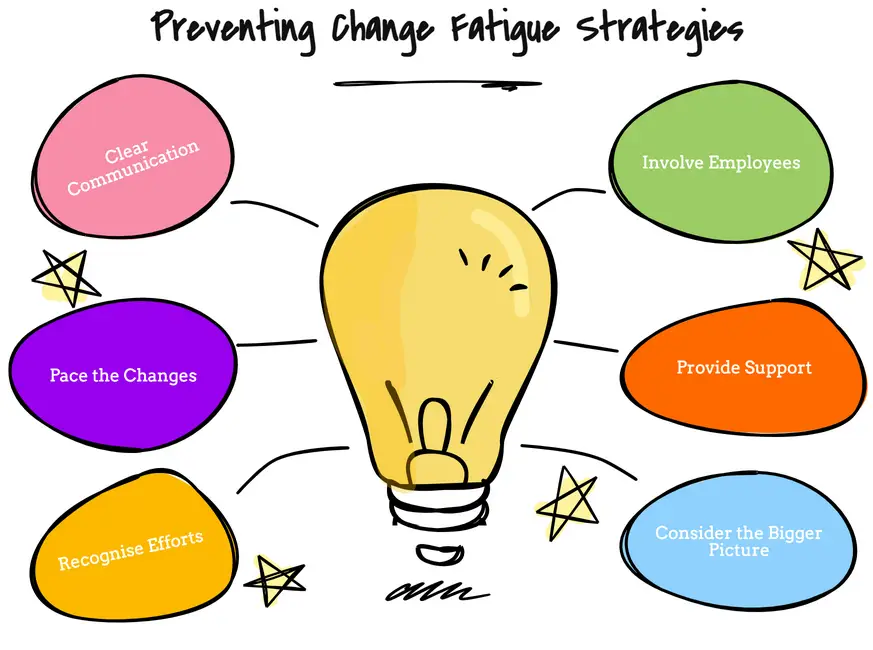Change Fatigue: Identification, Prevention and Support

Living in a world where the only constant is change—from new technologies and evolving workplace dynamics to shifting market demands—can often feel overwhelming, especially with the additional pressures from our personal lives.
Many of us grapple with change fatigue. Understanding the signs of this fatigue and ways to prevent and support individuals experiencing it is crucial for both employees and organisations as we strive to foster a healthy work environment.
What is Change Fatigue?
Change fatigue describes the exhaustion—mentally, emotionally, and physically—that arises from enduring constant organisational changes. It’s that sense of being overwhelmed when demands for adaptation keep piling up. This fatigue can result in decreased productivity, disengagement, and staff morale.
All aspects of our lives impact how we feel and function at work. Depending on what is happening externally and internally, our responses will vary. Recognising that we are all human—and ensuring a psychologically safe working environment where we feel supported—goes a long way toward fostering a workplace culture that genuinely cares about its people.

Recognising change fatigue
To tackle change fatigue effectively, we first need to identify the signs. Here are some indicators that might suggest it’s time to take a closer look:
Decreased Productivity: If employees struggle to keep up with their usual output and seem distracted, it’s a red flag.
Increased Resistance: A noticeable rise in pushback against new initiatives can signal that team members feel fatigued.
Emotional Reactions: Frustration, anxiety, or helplessness can surface as people deal with ongoing changes.
Withdrawal: If previously engaged employees start pulling back during meetings or collaborative tasks, it could be a sign of fatigue.
High Turnover Rates: A spike in voluntary resignations can point to more profound dissatisfaction linked to relentless changes.

preventing change fatigue
Here are some proactive strategies that organisations can adopt to prevent change fatigue from taking root:
Clear Communication: Keep lines of communication open about the reasons for changes and the expected benefits. This helps create a sense of ownership among employees and reduces uncertainty.
Involve Employees: Encourage feedback and involve the team in decision-making. When employees feel they have a say, it can significantly enhance buy-in and adoption.
Pace the Changes: Avoid overwhelming employees with multiple changes at once. Rolling out change in phases allows people to adjust more smoothly.
Provide Support and Training: Equipping employees with training and resources is vital. The more prepared they are, the more confident and resilient they’ll feel.
Recognise Efforts: Celebrating employees’ hard work and achievements during transitions can boost morale and keep spirits high.
looking at the bigger picture
When managing change within an organisation, it’s essential to consider the broader context. For instance, while introducing a new system, it’s crucial to recognise that other modifications may also be happening concurrently. This holistic view helps leaders understand how multiple shifts impact teams.
Tools like a “single view of change” can be invaluable. By mapping out all ongoing initiatives, decision-makers can see how different changes interconnect and where they may impact, helping optimise resource use and manage workloads more effectively. A comprehensive understanding allows leaders to make informed decisions that alleviate staff overload.
Supporting through change fatigue
Even with the best prevention strategies, change fatigue can still emerge. When it does, supporting employees effectively is essential. Here are some methods to consider:
Emotional Support: Offering access to counselling services or employee assistance programs (EAPs) can help staff navigate the emotional challenges of change.
Encourage Breaks: Create an environment where taking breaks and time off is not just accepted but encouraged. Everyone needs to recharge, especially during busy times.
Work-Life Balance: Flexible working arrangements can allow employees to juggle personal and professional commitments more effectively.
Feedback Mechanisms: Establish ways for team members to voice their concerns or experiences regarding changes. Regular check-ins can help leaders gauge sentiments and adapt accordingly.
Build Resilience: Providing resilience-building training supports employees in coping with challenges more effectively. Workshops on stress management can also be beneficial.

Understanding and addressing change fatigue is vital for individual well-being and organisational success.
By recognising the signs, implementing preventative strategies, and providing support during transitions, we can create an environment that encourages resilience, engagement, and productivity.
Prioritising employee well-being will mitigate change fatigue and help organisations thrive in a landscape that demands adaptability.
Check out our article to learn more about Psychologically safe environments.
Psychologically safe environments

